Unlike sugar scrubs made with only oils and sugar, emulsified sugar scrubs become a creamy exfoliating lotion upon contact with water, leaving no oily residue, but only soft, supple skin behind.
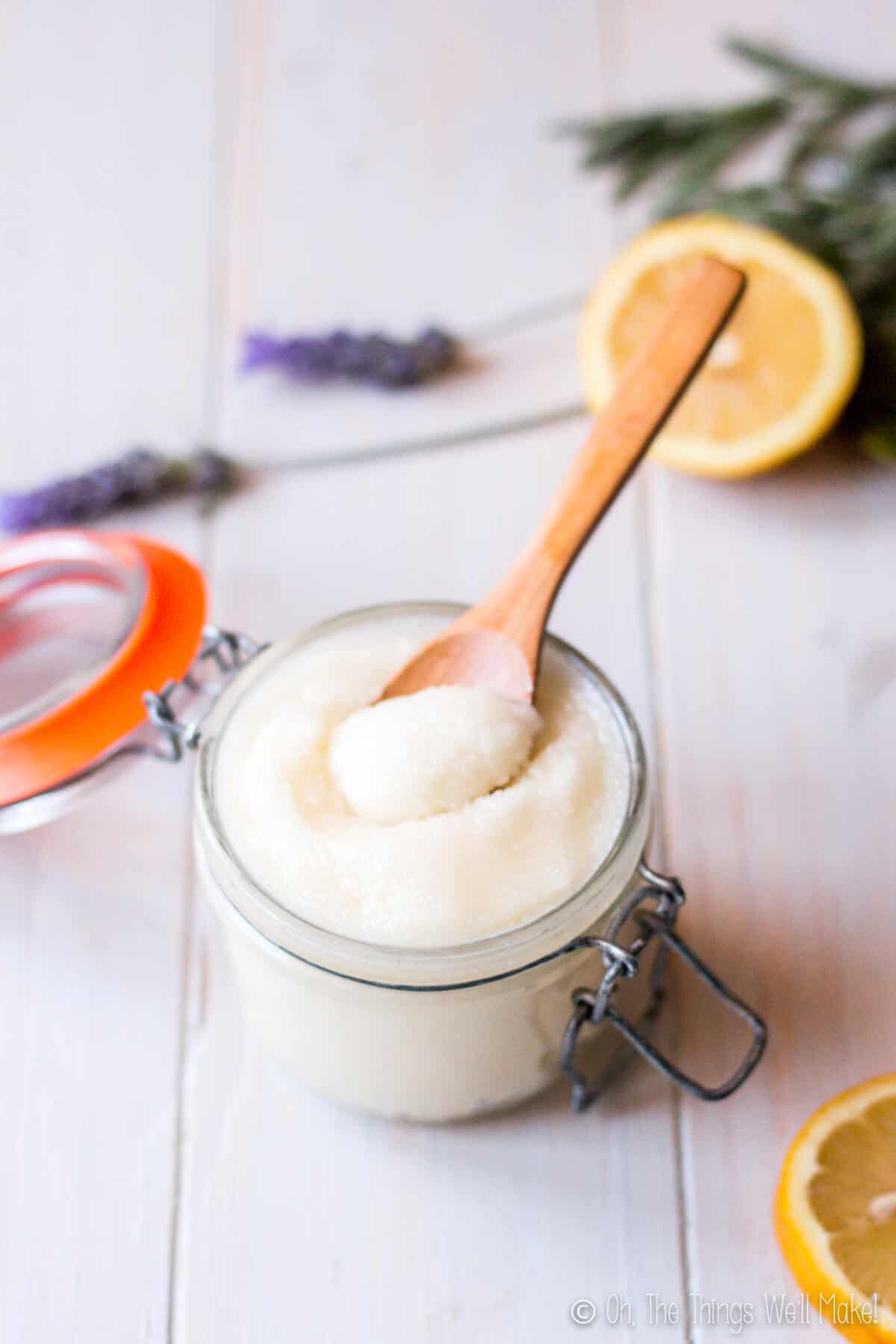
One of the most common DIY beauty products that can be found online is sugar and salt scrubs. Perhaps the main reason that these products are so popular is that they are very easy to make. Basically, you take some oil and mix it together with either sugar and salt, and you’re essentially done. Sure, you can customize your recipe with different oils, sugar types, essential oils, and/or add in other exfoliants or colorants, but most of these recipes are essentially the same.
I’m not going to criticize these recipes. In fact, one of the first DIY recipes on my blog was a brown sugar lip scrub. As you may have guessed, I mostly used it to exfoliate my lips, but also tried using it in the shower to exfoliate my skin.
The benefit of emulsified sugar scrubs
The problem with regular sugar scrubs is that they tend to be messy to use. The oil doesn’t provide a lot of structure for your product, so it’s usually hard to scoop into your hands to use in the shower. Sure, you can use coconut oil to give it more body, but as soon as the weather warms up, you’re back to a more liquid product.
You could, of course, add some butters and/or waxes to the scrub to thicken it, but we’re still left with the main problem with sugar scrubs, the oily residue. Because it’s an oil-based product, you usually end up with oil all over your hands, and body, and shower, as well as the container you’re using for your sugar scrub. I liked the smooth feeling of my legs and arms after exfoliating with my homemade sugar scrub but didn’t like the feel of the oily residue all over my body.
Emulsified sugar scrubs don’t leave that sort of oily residue behind. Because they include an emulsifier as one of their ingredients, when the oils and waxes of the product come in contact with water, they basically form an emulsion, or a lotion, on your skin while you are exfoliating away. In the end, emulsified sugar scrubs are like exfoliants and lotions in one product. You’re essentially making an exfoliating creamy cleanser right on your skin as you scrub away.
If you’re lazy like I am, and don’t like having to exfoliate, rinse, and then use lotion once out of the shower, this emulsified sugar scrub is the perfect solution. It leaves your skin clean, smooth, and lotioned up. (Is that a word?)
Watch me make this easy, emulsified sugar scrub:
Should you add a preservative to your sugar scrub?
Because this is still an oil-based product, without any water in it, you technically don’t have to add a preservative to it. The problem with not using a preservative, though, is that you use this product in a very wet environment and likely scoop it out of the jar with wet hands. The likelihood of moisture contaminating your product is very, very high.
That’s why preservatives are usually added to these types of products, and why you have to be very, very careful using it if you choose not to add a preservative. You could even consider adding less sugar and less wax to the scrub so that you end up with a thinner product that you could more easily dispense from a silicone travel tube dispenser or another type of flip cap dispenser. That would allow you to dispense the product without touching it and would help keep water from contaminating your product.
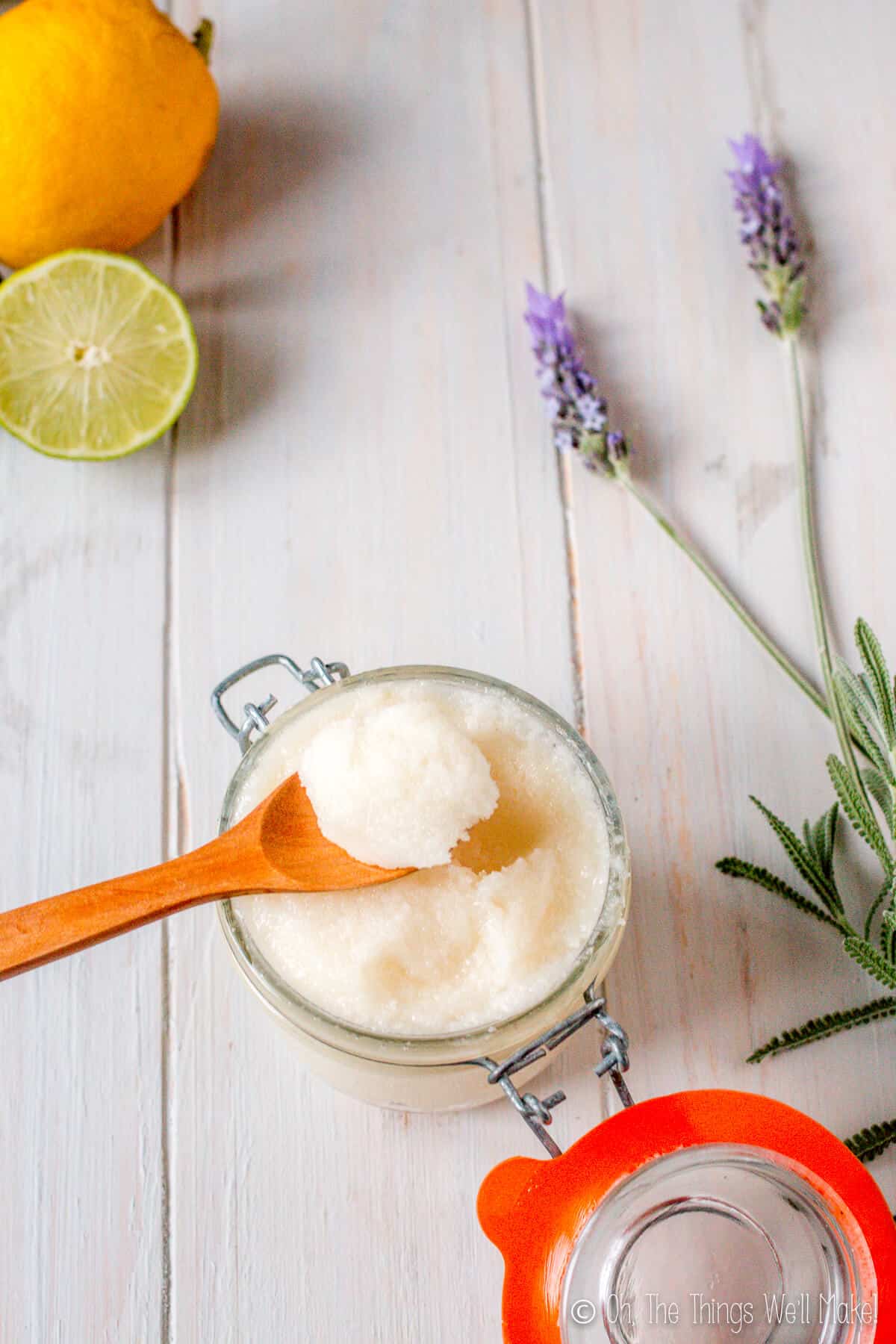
Customizing the emulsified sugar scrub
There are several ways that you can customize this recipe to better suit your taste.
Changing the exfoliant: Salt, sugar, or brown sugar?
While I made this a sugar scrub, you could just as easily add salt to the recipe instead. Salt tends to be a bit more abrasive because the granules aren’t as round and it takes longer for the salt to dissolve, but it really depends on the coarseness of whatever you choose to use. Brown sugar usually has smaller granules and tends to be a lot less abrasive, making it a great option for exfoliating your face.
How much sugar should I use?
When I first made the recipe, I used 120g of sugar and found it to be a nice texture. The next time I made it, I decided I would add more sugar, around 30g more, thinking I’d end up with a thicker scrub (and more of it). In the end, I think it may be a bit on the thick side (as you can see at the end of my video when I’m applying the scrub). It still works well, especially if you are applying it to wet skin, but is a bit harder to apply if it isn’t thinned out with a bit of water. I think somewhere between 120g-150g is a good guideline, and you can adjust the amount to achieve the consistency you prefer.
Customizing the fragrance
I used a combination of lavender, rosemary, and lemon essential oils because I tend to favor citrus herbal scents. You can change the essential oils, though, to suit your tastes. I like lavender because it is calming and soothing for relaxing after a busy day. Lemon can be both soothing or invigorating depending on what you mix it with and when you use it. I don’t normally measure out my essential oils, but use my nose to help decide how much to add.
Which emulsifying wax should you use?
You can use any emulsifying wax that you may happen to have on hand. If you make your own homemade lotions, you should already have one or two of them at home.
If you are very concerned about making a very natural emulsified sugar scrub, consider using an emulsifying wax like olivem. Olivem is a vegetable based emulsifier that is derived from olives. It is allowed in natural, organic products that use the ECO-CERT certification. Olivem is a great option for an emulsifying scrub, too, because some people say that it has a bit of a soap feel to it. In the case of a cleanser, that is more of an advantage than a disadvantage.
Basic, Easy Emulsified Sugar Scrub
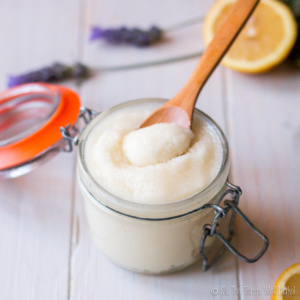
Emulsified Sugar Scrub
Ingredients
- 50 g oil I used sweet almond oil
- 10 g cocoa butter
- 10 g shea butter
- 10 g beeswax or candelilla wax
- 15 g emulsifying wax Olivem is a great choice for this!
- 1 g essential oil (I used lavender, rosemary, and lemon)
- 1 g cosgard or other natural preservative used at the recommended dose
- 150 g sugar (Use less for a slightly thinner product)
Instructions
- Weigh out ad mix together the first 5 ingredients: the oil (but not essential oils), butters, and waxes.
- Melt the oils, butters, and waxes over a double boiler (or in the microwave, if you prefer).
- Once melted, remove from the heat, and stir occasionally as the mixture cools. You can use a mixer to help blend everything together and make a creamy mixture, but it’s not essential.
- Once your mixture has cooled down quite a bit (ideally below 45ºC/115ºF), you can begin to add the essential oils and preservative.
- Make sure the essential oils and preservative are well incorporated into your oils and then begin to add the sugar. Add slowly, and stir constantly, so you can gauge the consistency of the product. Add as much sugar as you like to achieve the desired consistency. (I like it somewhere between 120-150g.)
- To use your sugar scrub, scoop out a small amount in your hands and begin to rub over your wet arms and legs (or any areas you want to exfoliate and hydrate) in a circular motion. As the mixture comes into contact with the water, a lotion will be formed, and the sugar will begin to dissolve, making the product smoother and less abrasive. Rinse any remaining sugar crystals off, and pat your skin dry. Your skin should now feel smooth and hydrated.
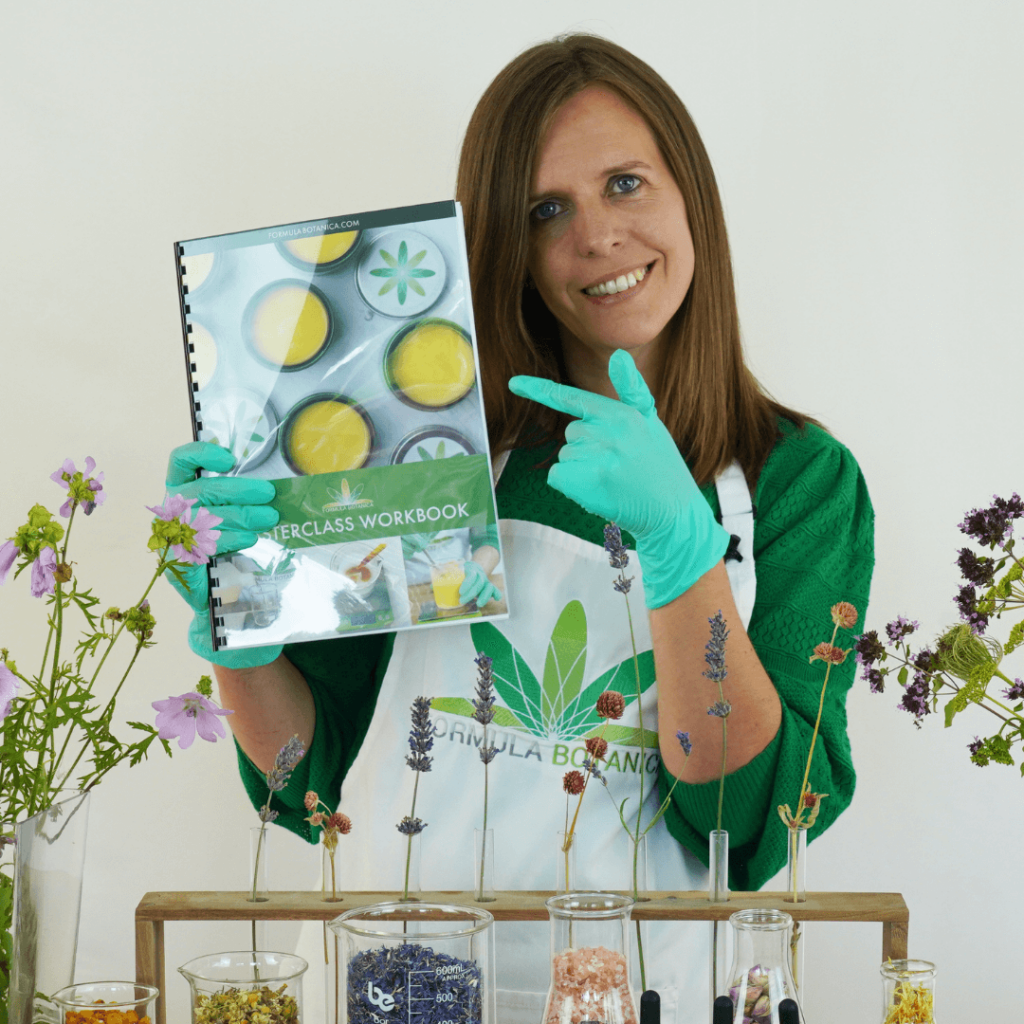
Free Formula Botanic Masterclass!
Running now…
9 free 10-minute classes to help you learn to begin developing professional-grade natural cosmetics in your own home!
 Español
Español
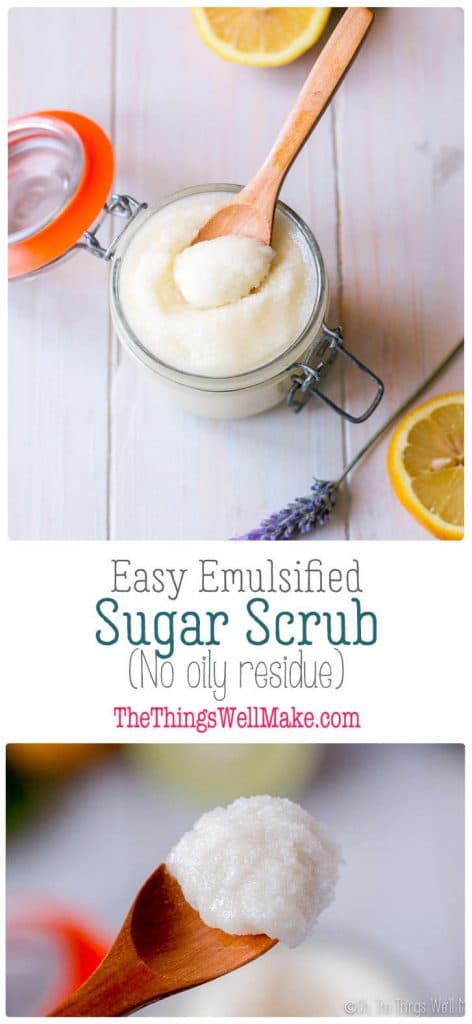
 What are Bitters, and How to Make Them
What are Bitters, and How to Make Them
Kiki
Hi Tracy.
As my favorite formulator, I love all your recipes. But I’m trying to make a scrub with honey and salycilic acid. Can I incorporate these into the sugar scrub? At what quantities? Thanks
Tracy Ariza, DDS
Hi Kiki,
The problem with adding something like honey into this is that it makes it a lot more prone to microbial growth. Right now, this is an oil based recipe without any water-based ingredients. Adding them would mean that you would definitely need a preservative. I’m not sure how well honey would emulsify in either as I haven’t even tried it. Salicylic acid, on the other hand, can be found in both a powder and a liquid. I’d stick to trying with a powder vs. a liquid, but also not sure what the final outcome would be like. I’d follow the dosage suggested by your supplier for the particular acid. (They can vary by concentration, etc.)
Ed
Too oily / “waxy” for me 🙁 do you have any suggestions on what ingredients can i remove?
Tracy Ariza, DDS
Hi Ed,
You can remove the beeswax.
I have made several batches recently and have been planning on updating this post with more possibilities!
Without the wax, it will be a bit more liquid, but when you add the sugar, that isn’t really a problem.
Kelley Spartiatis
I wouldn’t use beeswax in this. You can up the butter % or use cetyl or cetearyl alcohol instead of beeswax. For even less of an oily feel you can use mango butter which is less oily and use a dey feeling oil like ricebran
Tracy Ariza, DDS
Agreed- it’s perfectly fine to make this without the beeswax and it will make it a lot lighter. I’ve since made this with only oils and different emulsifiers and it works well pretty much no matter what you use. It’s a very forgiving recipe!
Shirley
I made a very basic sugar and salt scrub with fractionated coconut oil. It is exactly as you said, leaving my skin feeling very oily.
Is it possible to add the emulsifying wax after the fact? Or some other fix?
I’ll try this recipe in the future but wondering if I can salvage any of the current batch.
Tracy Ariza, DDS
Hi Shirley,
Sorry for the delayed response. I got a bit behind on comments at the end of the summer when school was about to start.
The only way I can think of somewhat remedying this would be to make a very thick emulsion (small amount of oils and higher amount of emulsifier) and then trying to mix yours into it. I’m not sure if it would actually work, but I think it’s your only shot. I guess if it didn’t work by just stirring it together, you’d have to try heating the whole mixtur
The problem is that if you already have the sugar in it, trying to melt what you have with the emulsifying wax may affect the sugar. It doesn’t have water, so it probably wouldn’t dissolve, but it may caramelize if the heat is enough. Of course, if mixing it into the emulsion isn’t working, the only other thing you can try is to try to heat it all gently over a double boiler while mixing it all together.
Without having tried this, I’m just guessing at what I would try if it were me. 😉
P williams
Hi I was just wondering if I can put fresh lemon juice and bottle cranberry juice in to my scrubs for resale and if they would last long.
Tracy Ariza, DDS
Any time you add food ingredients, the final product is more difficult to preserve.
In this case, the scrub doesn’t have any water-based ingredients, so it doesn’t really need a preservative (if used in a way that water isn’t introduced) and has a very long shelf life. The second you add a liquid to it, you’d need to try to emulsify the ingredients together so the process would be different. You’d also need a preservative and the shelf life would really depend on the preservative used and what ingredients you’d add. In most countries you’d have to do microbial testing to know how long your product keeps and to be able to sell it legally.
The other issue with adding a juice is that it may end up dissolving some of the sugar. You could use coarser crystals to help compensate the issue, but I’m not sure what the result would be.
Lisa
Hello,
Thanks for your great recipe? May I ask if I could put oatmeal into the sugar scrub? Is it limit the shelf life of the scrub? Thanks very much
Tracy Ariza, DDS
Hi Lisa,
Yes, you could definitely do that, but, yes, in a way, it could limit the shelf life.
If the scrub stays completely dry, it shouldn’t make a difference.
The likelihood of water getting into the jar, though, and affecting the oatmeal is quite high. In the case of oatmeal, I think it would be much more important to add a preservative to this recipe for any possible contamination with water.
Josette Berksteiner
Can you tell me the name of the digital container you used to measure the ingredients?
Tracy Ariza, DDS
It’s just an [eafl id="25419" name="kitchen scale" text="inexpensive digital kitchen scale"]. You can also use a [eafl id="19291" name="jeweler's scale" text="jeweler's scale"] for weighing out smaller amounts. That’s especially handy for things like the preservative and essential oils.
Cou Cou
Hi , cosgard is water soluble is it safe to use it in this recipe ? Thanks
Tracy Ariza, DDS
It shouldn’t be a problem, especially with the emulsifier.
anshika mehta
hello, i have seen your recipe and its really really good, but i have one question, its that i am starting my small skincare business and and i live in india and here optiphen and cosgard is not available and the option i have is only phynenoxthenol and optiphen plus so can you help me with and any idea where i can use optiphen plus i currently have this so can you help me with the recipe?
Tracy Ariza, DDS
Hi Anshika,
Optiphen plus should be fine. Just use the dosage suggested by your supplier. (I think around 1% by weight should be about right.)
Depending on the regulations in your country, you may have to do microbial testing to see how well your preservative functions in your recipe (even when you abuse the product by intentionally contaminating it with water, etc.)
Emma
How many ounces does this recipe make?
Tracy Ariza, DDS
Between 8.5-9 ounces (by weight).
Liz
While this is no doubt a luxurious product, the long term issue is what it does to a shower drain. Using products with any kind of wax, be it emulsifying wax, beeswax, candelilla or any other, can cause major plumbing problems–it happened to me. Over time, the drain gets coated in the wax, trapping hair etc. For me, it wound up causing a clog in the main drain of my house, and I wound up paying nearly $1000 to a drain cleaning company. As a seller, I would not have my customers use products that may cause similar problems. Emulsifying wax is great for lotions that you don’t rinse off down the drain.
Tracy Ariza, DDS
Hi Liz,
There are many reasons for a clogged drain. Soap can build up with layers of soap scum, and I find that’s more common than anything from lotions and other products with emulsifying wax.
When you rub the scrub into your wet skin, it becomes a lotion and rinses well. If people apply lotion to their skin, they will eventually rinse them off down the drain too. In larger amounts, all hair conditioners use emulsifying wax and are rinsed. I suppose you avoid them all too?
In full disclosure, I removed your one-star rating of the recipe as you haven’t actually tried it and have only come and commented to try to drive down the rating. I’m not sure why you even came to a post for an emulsified sugar scrub if you are so set against emulsified scrubs to begin with.
Kelley Spartiatis
I would personally make a few changes but that is purely preference.
This recipe will work perfectly as intended.
Tracy Ariza, DDS
Thanks, Kelley!
Lori
Hi there,
I made this recipe today and really like it but wondering if I can change out the cocoa butter for something else. I find that it takes over any fragrance I put in because the cocoa smell is so strong.
Tracy Ariza, DDS
Hi Lori,
Yes! This recipe is really forgiving. You could use a different butter. Any of them should work. (Other butters will make it slight softer, but that isn’t a problem in this recipe!)
You could also look for refined cocoa butter. I usually use refined because I also am bothered by the overpowering scent of unrefined cocoa butter.
Z Smith
Thank you for this recipe! One question using this exact recipe with the measurements you gave how many 8 oz containers do you think it’ll fill? (I’m trying not to over-buy many things and to try to get nearly accurate measurements for my project, based on your recipe)
Tracy Ariza, DDS
Hello,
The recipe made the amount in the photo. I’m not sure in ounces. (If we’re talking fluid ounces, I think 8 is around a cup and my container is slightly larger than that, but not much.) It will probably also slightly depend on the amount of sugar you add, but I’d guess it will likely be either one that is full or a bit more than one. You should probably have 2 containers ready, just in case. I like to fill one, and then add any extra to a smaller, separate container for refilling into the first, as needed.
Zita kaneme
Hi Tracy,
I really like your recipe and want to replicate it. But I am having a challenge with the preservative. I can only find Potassium sorbate and Cetrimonium chloride. Should I use both or just one? What do you recommend?
Tracy Ariza, DDS
Hi Zita,
Thank you!
From what I understand, the preservatives that they sell use a variety of different substances (vs. just one) to ensure they are effective against a wide variety of different microbes. Trying to come up with a combination that is effective at home would require doing microbial testing on your products with different concentrations of the substances. That’s why I prefer to use tried-and-true preservatives that have been shown to be effective as broad-spectrum preservatives.
In the case of this oil-based recipe, as it’s not really needed as long as you keep the product dry and clean, it’s not as big of a deal if it’s for home use (you can be careful when using it), but in some recipes it would be very important to get right.
Janelle
Hello,
I’m interested in trying this recipe out myself. Could you provide it in percentages?
Tracy Ariza, DDS
Hi Janelle,
If you ignore the sugar portion, the rest of the recipe adds up to just shy of 100grams. (It was originally 100g, but I made some changes at the last minute, not adding some additives to simplify the recipe, so it ended up being just short of 100g.)
Anyway, you can add a gram of each of the fats and you’s end up with 100g…
So, 51% oil, 11% cocoa butter, 11% shea butter, 10% beeswax or candelilla wax, 15% emulsifying wax, 1% essential oil, 1% preservative (use recommended dose for your preservative).